An Investigation of the Influence of Gas Injection Rate Shape on High-Pressure Direct-Injection Natural Gas Marine Engines
Abstract
1. Introduction
2. Numerical Simulation Model
2.1. Test Engine
2.2. Numerical Simulation Model
2.3. Validation
3. Results and Discussion
3.1. Combustion Characteristics
3.2. Emissions
4. Conclusions
Author Contributions
Funding
Conflicts of Interest
References
- IMO, A.V. 73/78 Regulations for the Prevention of Air Pollution from Ships and NOx Technical Code; International Maritime Organization: London, UK, 1998. [Google Scholar]
- Krivopolianskii, V.; Valberg, I.; Stenersen, D.; Ushakov, S.; Æsøy, V. Control of the combustion process and emission formation in marine gas engines. J. Mar. Sci. Technol. 2018, 24, 593–611. [Google Scholar] [CrossRef]
- Shen, Z.; Cui, W.; Ju, X.; Liu, Z.; Wu, S.; Yang, J. Numerical Investigation on Effects of Assigned EGR Stratification on a Heavy Duty Diesel Engine with Two-Stage Fuel Injection. Energies 2018, 11, 515. [Google Scholar] [CrossRef]
- Dnv, G. IMO NOx Tier III Requirements to Take Effect on 1 January 2016. Available online: https://www.dnvgl.com/news/imo-nox-tier-iii-requirements-to-take-effect-on-january-1st-2016-51970 (accessed on 17 December 2015).
- Kim, D.; Lee, C. SCR Performance Evaluations in Relation to Experimental Parameters in a Marine Generator Engine. J. Mar. Sci. Eng. 2019, 7, 67. [Google Scholar] [CrossRef]
- Wu, Y.Y.; Jang, C.T. Combustion Analysis of Homogeneous Charge Compression Ignition in a Motorcycle Engine Using a Dual-Fuel with Exhaust Gas Recirculation. Energies 2019, 12, 847. [Google Scholar] [CrossRef]
- Mahmoudzadeh, A.A.; Pesyridis, A.; Esfahanian, V.; Said, M.F.M. Combustion and Emission Enhancement of a Spark Ignition Two-Stroke Cycle Engine Utilizing Internal and External Exhaust Gas Recirculation Approach at Low-Load Operation. Energies 2019, 12, 609. [Google Scholar] [CrossRef]
- Chala, G.; Abd Aziz, A.; Hagos, F. Natural Gas Engine Technologies: Challenges and Energy Sustainability Issue. Energies 2018, 11, 2934. [Google Scholar] [CrossRef]
- Brynolf, S.; Magnusson, M.; Fridell, E.; Andersson, K. Compliance possibilities for the future ECA regulations through the use of abatement technologies or change of fuels. Transp. Res. Part D Transp. Environ. 2014, 28, 6–18. [Google Scholar] [CrossRef]
- Briggs, J.; McCarney, J. Field experience of Marine SCR. In Proceedings of the CIMAC Congress 2016, Helsinki, Finland, 6–10 June 2016. [Google Scholar]
- Zamboni, G. Influence of Fuel Injection, Turbocharging and EGR Systems Control on Combustion Parameters in an Automotive Diesel Engine. Appl. Sci. 2019, 9, 484. [Google Scholar] [CrossRef]
- Park, S.; Lee, K.; Park, J. Parametric Study on EGR Cooler Fouling Mechanism Using Model Gas and Light-Duty Diesel Engine Exhaust Gas. Energies 2018, 11, 3161. [Google Scholar] [CrossRef]
- Zheng, J.; Hu, E.; Huang, Z.; Ning, D.; Wang, J. Combustion and emission characteristics of a spray guided direct-injection spark-ignition engine fueled with natural gas-hydrogen blends. Int. J. Hydrogen Energy 2011, 36, 11155–11163. [Google Scholar] [CrossRef]
- Xu, M.; Cheng, W.; Zhang, H.; An, T.; Zhang, S. Effect of diesel pre-injection timing on combustion and emission characteristics of compression ignited natural gas engine. Energy Convers. Manag. 2016, 117, 86–94. [Google Scholar] [CrossRef]
- Papagiannakis, R.; Rakopoulos, D.; Rakopoulos, C. Evaluation of the Air Oxygen Enrichment Effects on Combustion and Emissions of Natural Gas/Diesel Dual-Fuel Engines at Various Loads and Pilot Fuel Quantities. Energies 2018, 11, 3028. [Google Scholar] [CrossRef]
- Gaikwad, M.S.; Jadhav, K.M.; Kolekar, A.H.; Chitragar, P.R. Combustion characteristics of biomethane–diesel dual-fueled CI engine with exhaust gas recirculation. Biofuels 2018. [Google Scholar] [CrossRef]
- Abdelaal, M.M.; Hegab, A.H. Combustion and emission characteristics of a natural gas-fueled diesel engine with EGR. Energy Convers. Manag. 2012, 64, 301–312. [Google Scholar] [CrossRef]
- Chen, Z.; Zhang, F.; Xu, B.; Zhang, Q.; Liu, J. Influence of methane content on a LNG heavy-duty engine with high compression ratio. Energy 2017, 128, 329–336. [Google Scholar] [CrossRef]
- Liu, J.; Zhang, X.; Wang, T.; Zhang, J.; Wang, H. Experimental and numerical study of the pollution formation in a diesel/CNG dual fuel engine. Fuel 2015, 159, 418–429. [Google Scholar] [CrossRef]
- Liu, J.; Wang, J.; Zhao, H. Optimization of the injection parameters and combustion chamber geometries of a diesel/natural gas RCCI engine. Energy 2018, 164, 837–852. [Google Scholar] [CrossRef]
- Zhang, Q.; Li, M.; Shao, S. Combustion process and emissions of a heavy-duty engine fueled with directly injected natural gas and pilot diesel. Appl. Energy 2015, 157, 217–228. [Google Scholar] [CrossRef]
- Liu, J.; Zhao, H.; Wang, J.; Zhang, N. Optimization of the injection parameters of a diesel/natural gas dual fuel engine with multi-objective evolutionary algorithms. Appl. Therm. Eng. 2019, 150, 70–79. [Google Scholar] [CrossRef]
- Juliussen, L.; Kryger, M.; Andreasen, A. Man B&W Me-Gi engines. recent research and results. In Proceedings of the International Symposium of Marine Engineering, Kobe, Japan, 17–21 October 2011. [Google Scholar]
- Juliussen, L.; Mayer, S.; Kryger, M. The MAN ME-GI engine: From initial system considerations to implementation and performance optimization. In Proceedings of the CIMAC Congress 2016, Helsinki, Finland, 6–10 June 2016. [Google Scholar]
- Klausner, J.; Trapp, C.; Schaumberger, H. The gas engine of the future–innova-tive combustion and high compression ratios for highest efficiencies. In Proceedings of the CIMAC Congress 2010, Bergen, Norway, 14–17 June 2010. [Google Scholar]
- Nylund, I.; Ott, M. Development of a Dual Fuel technology for slow-speed engines. In Proceedings of the CIMAC Congress 2013, Shanghai, China, 13–16 May 2013. [Google Scholar]
- Redtenbacher, C.; Kiesling, C.; Wimmer, A.; Sprenger, F.; Fasching, P.; Eichelseder, H. Dual Fuel Brennverfahren-Ein Zukunftsweisendes Konzept Vom PKW-Bis Zum Großmotorenbereich? In Proceedings of the 37th International Vienna Motor Symposium, Vienna, Austria, 28–29 April 2016; pp. 403–428. [Google Scholar]
- Eder, L.; Ban, M.; Pirker, G.; Vujanovic, M.; Priesching, P.; Wimmer, A. Development and Validation of 3D-CFD Injection and Combustion Models for Dual Fuel Combustion in Diesel Ignited Large Gas Engines. Energies 2018, 11, 643. [Google Scholar] [CrossRef]
- He, Z.; Xuan, T.; Xue, Y.; Wang, Q.; Zhang, L. A numerical study of the effects of injection rate shape on combustion and emission of diesel engines. Therm. Sci. 2014, 18, 67–78. [Google Scholar] [CrossRef][Green Version]
- Rohani, B.; Bae, C. Effect of exhaust gas recirculation (EGR) and multiple injections on diesel soot nano-structure and reactivity. Appl. Therm. Eng. 2017, 116, 160–169. [Google Scholar] [CrossRef]
- Hinkelbein, J.; Sandikcioglu, C.; Pischinger, S.; Lamping, M.; Körfer, T. Control of the diesel combustion process via advanced closed loop combustion control and a flexible injection rate shaping tool. SAE Int. J. Fuels Lubr. 2010, 2, 362–375. [Google Scholar] [CrossRef]
- Bai, F.; Zhang, Z.; Du, Y.; Zhang, F.; Peng, Z. Effects of injection rate profile on combustion process and emissions in a diesel engine. J. Combust. 2017. [Google Scholar] [CrossRef]
- Mohan, B.; Yang, W.; Yu, W.; Tay, K.L.; Chou, S.K. Numerical investigation on the effects of injection rate shaping on combustion and emission characteristics of biodiesel fueled CI engine. Appl. Energy 2015, 160, 737–745. [Google Scholar] [CrossRef]
- Macian, V.; Payri, R.; Ruiz, S.; Bardi, M.; Plazas, A.H. Experimental study of the relationship between injection rate shape and Diesel ignition using a novel piezo-actuated direct-acting injector. Appl. Energy 2014, 118, 100–113. [Google Scholar] [CrossRef]
- Shuai, S.; Abani, N.; Yoshikawa, T.; Reitz, R.D.; Park, S.W. Evaluation of the effects of injection timing and rate-shape on diesel low temperature combustion using advanced CFD modeling. Fuel 2009, 88, 1235–1244. [Google Scholar] [CrossRef]
- Hountalas, D.T.; Kouremenos, D.A.; Pariotis, E.G.; Schwarz, V.; Binder, K.B. Using a phenomenological multi-zone model to investigate the effect of injection rate shaping on performance and pollutants of a DI heavy duty diesel engine. SAE Trans. 2002, 111, 358–375. [Google Scholar]
- Benajes, J.; Payri, R.; Molina, S.; Soare, V. Investigation of the influence of injection rate shaping on the spray characteristics in a diesel common rail system equipped with a piston amplifier. J. Fluids Eng. 2005, 127, 1102–1110. [Google Scholar] [CrossRef]
- Kohketsu, S.; Tanabe, K.; Mori, K. Flexibly controlled injection rate shape with next generation common rail system for heavy duty DI diesel engines. SAE Trans. 2000, 109, 459–468. [Google Scholar]
- Desantes, J.M.; Benajes, J.; Molina, S.; Gonzalez, C.A. The Modification of the Fuel Injection Rate in Heavy-Duty Diesel Engines, Part 1: Effects on Engine Performance and Emissions. Appl. Therm. Eng. 2004, 24, 2701–2714. [Google Scholar] [CrossRef]
- Desantes, J.M.; Benajes, J.; Molina, S.; Gonzalez, C.A. The Modification of the Fuel Injection Rate in Heavy-Duty Diesel Engines, Part 2: Effects on Combustion. Appl. Therm. Eng. 2004, 24, 2715–2726. [Google Scholar] [CrossRef]
- Luckhchoura, V. Modeling of Injection-Rate Shaping in Diesel Engine Combustion. Ph.D. Thesis, RWTH Aachen University, Aachen, Germany, 2010. [Google Scholar]
- Turbo, M.D. Basic Principles of Ship Propulsion. Available online: https://marine.man-es.com/propeller-aftship/basicprinciples-of-propulsion (accessed on 17 October 2018).
- Richards, K.J.; Senecal, P.K.; Pomraning, E. CONVERGE Manual (Version 2.3); Convergent Science Inc.: Madison, WI, USA, 2016. [Google Scholar]
- Senecal, P.K.; Richards, K.J.; Pomraning, E.; Yang, T.; Dai, M.Z.; McDavid, R.M.; Shethaji, T. A new parallel cut-cell Cartesian CFD code for rapid grid generation applied to in-cylinder diesel engine simulations. SAE Tech. Pap. 2007, 1, 159. [Google Scholar]
- Ashok, B.; Nanthagopal, K. Eco friendly biofuels for CI engine applications. In Advances in Eco-Fuels for a Sustainable Environment; Azad, K., Ed.; Woodhead Publishing: Amsterdam, The Netherlands, 2019; pp. 407–440. [Google Scholar]
- Golimowski, W.; Krzaczek, P.; Marcinkowski, D.; Gracz, W.; Wałowski, G. Impact of Biogas and Waste Fats Methyl Esters on NO, NO2, CO, and PM Emission by Dual Fuel Diesel Engine. Sustainability 2019, 11, 1799. [Google Scholar] [CrossRef]
- Schmidt, D.P.; Rutland, C.J. A new droplet collision algorithm. J. Comput. Phys. 2000, 164, 62–80. [Google Scholar] [CrossRef]
- O’Rourke, P.J.; Amsden, A.A. A spray/wall interaction submodel for the KIVA-3 wall film model. SAE Trans. 2000, 109, 281–298. [Google Scholar]
- Beale, J.C.; Reitz, R.D. Modeling spray atomization with the Kelvin-Helmholtz/Rayleigh-Taylor hybrid model. At. Sprays 1999, 9. [Google Scholar] [CrossRef]
- Le Moine, J.; Senecal, P.K.; Kaiser, S.A.; Salazar, V.M.; Anders, J.W.; Svensson, K.I.; Gehrke, C.R. A Computational Study of the Mixture Preparation in a Direct–Injection Hydrogen Engine. J. Eng. Gas Turbines Power 2015, 137, 111508. [Google Scholar] [CrossRef]
- Yakhot, V.; Orszag, S.A. Renormalization group analysis of turbulence. I. Basic theory. J. Sci. Comput. 1986, 1, 3–51. [Google Scholar] [CrossRef]
- Dukowicz, J.K. A particle-fluid numerical model for liquid sprays. J. Comput. Phys. 1980, 35, 229–253. [Google Scholar] [CrossRef]
- Maroteaux, F.; Saad, C. Combined mean value engine model and crank angle resolved in-cylinder modeling with NOx emissions model for real-time Diesel engine simulations at high engine speed. Energy 2015, 88, 515–527. [Google Scholar] [CrossRef]
- Paykani, A.; Kakaee, A.H.; Rahnama, P.; Reitz, R.D. Effects of diesel injection strategy on natural gas/diesel reactivity controlled compression ignition combustion. Energy 2015, 90, 814–826. [Google Scholar] [CrossRef]
- Scarcelli, R.; Wallner, T.; Matthias, N.; Salazar, V.; Kaiser, S. Mixture formation in direct injection hydrogen engines: CFD and optical analysis of single-and multi-hole nozzles. SAE Int. J. Engines 2011, 4, 2361–2375. [Google Scholar] [CrossRef]
- Scarcelli, R.; Wallner, T.; Matthias, N.; Salazar, V.; Kaiser, S. Numerical and optical evolution of gaseous jets in direct injection hydrogen engines. SAE Tech. Pap. 2011, 1, 675. [Google Scholar]
- Scarcelli, R.; Wallner, T.; Obermair, H.; Salazar, V.M.; Kaiser, S.A. CFD and optical investigations of fluid dynamics and mixture formation in a DI-H2ICE. In Proceedings of the ASME 2010 Internal Combustion Engine Division Fall Technical Conference, San Antonio, TX, USA, 12–15 September 2010; American Society of Mechanical Engineers: New York, NY, USA, 2010; pp. 175–188. [Google Scholar]
- White, T.R. Simultaneous Diesel and Natural Gas Injection for Dual-Fueling Compression-Ignition Engines; University of New South Wales: Sydney, Australia, 2006. [Google Scholar]
- Sun, X.; Liang, X.; Shu, G.; Wang, Y.; Wang, Y.; Yu, H. Effect of different combustion models and alternative fuels on two-stroke marine diesel engine performance. Appl. Therm. Eng. 2017, 115, 597–606. [Google Scholar] [CrossRef]
- Emission Standards. IMO Marine Engine. Available online: http://www.DieselNet.com/standards (accessed on 13 August 2011).
- Chen, Z. Effects of radiation and compression on propagating spherical flames of methane/air mixtures near the lean flammability limit. Combust. Flame 2010, 157, 2267–2276. [Google Scholar] [CrossRef]

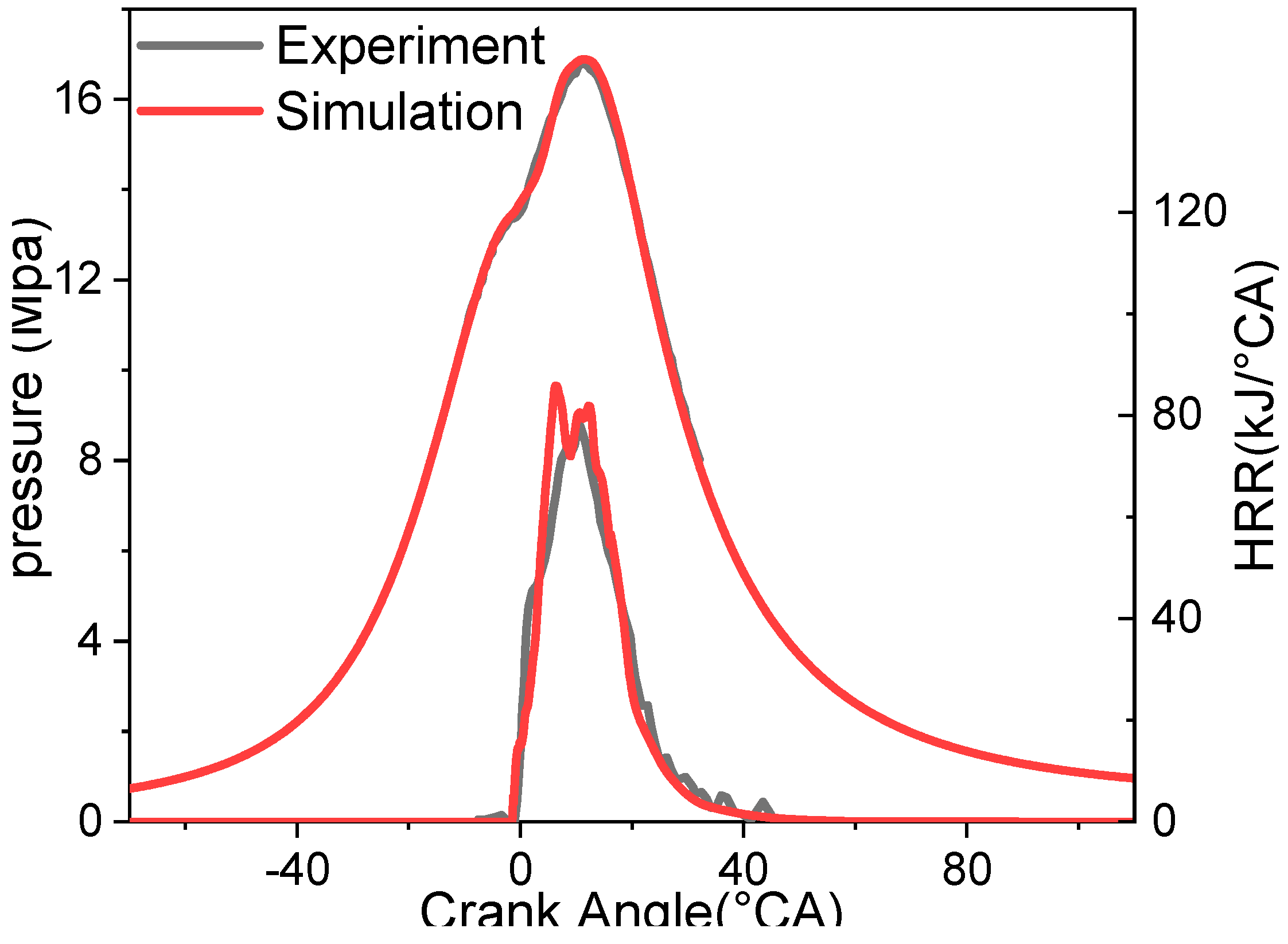


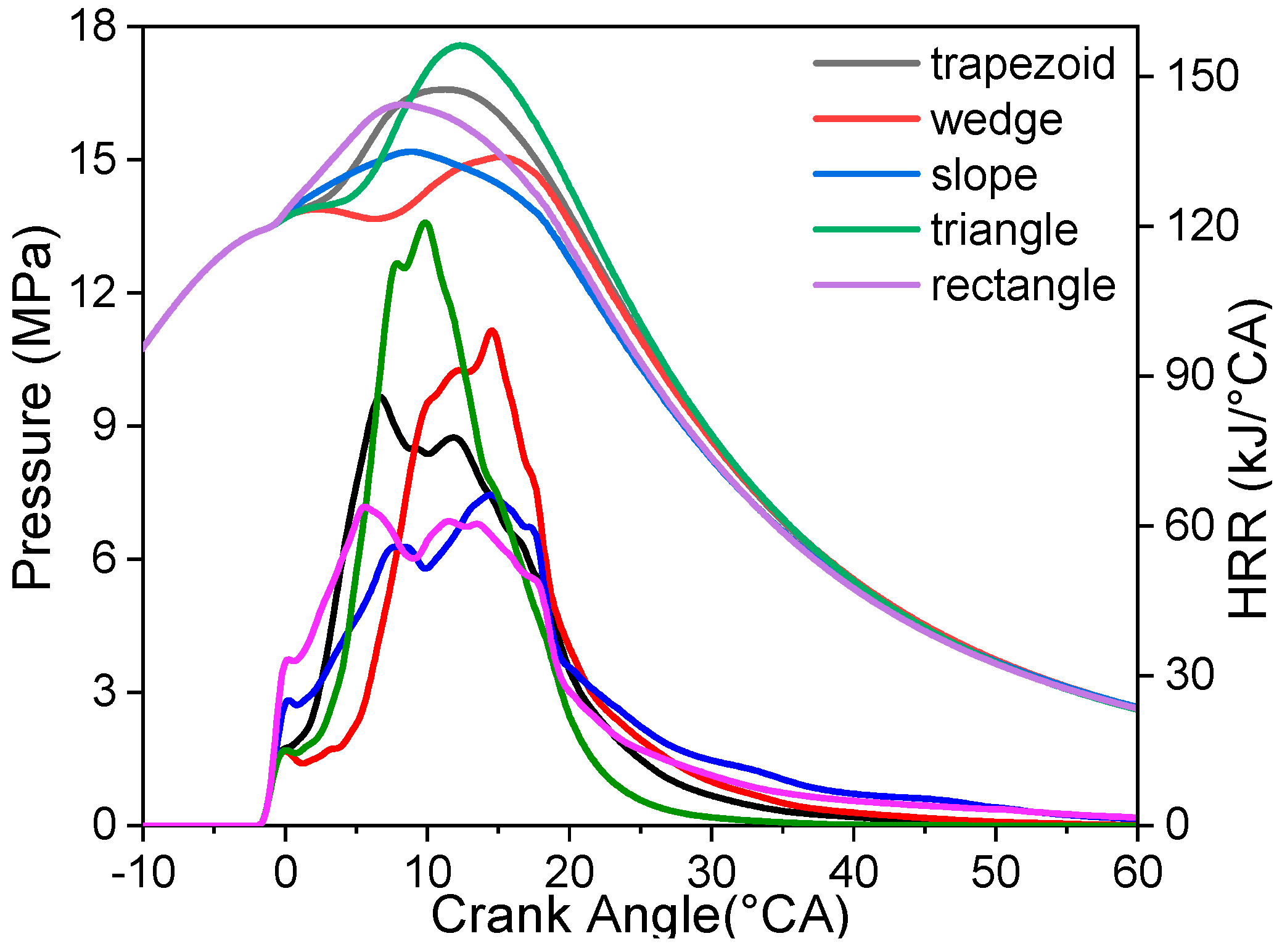

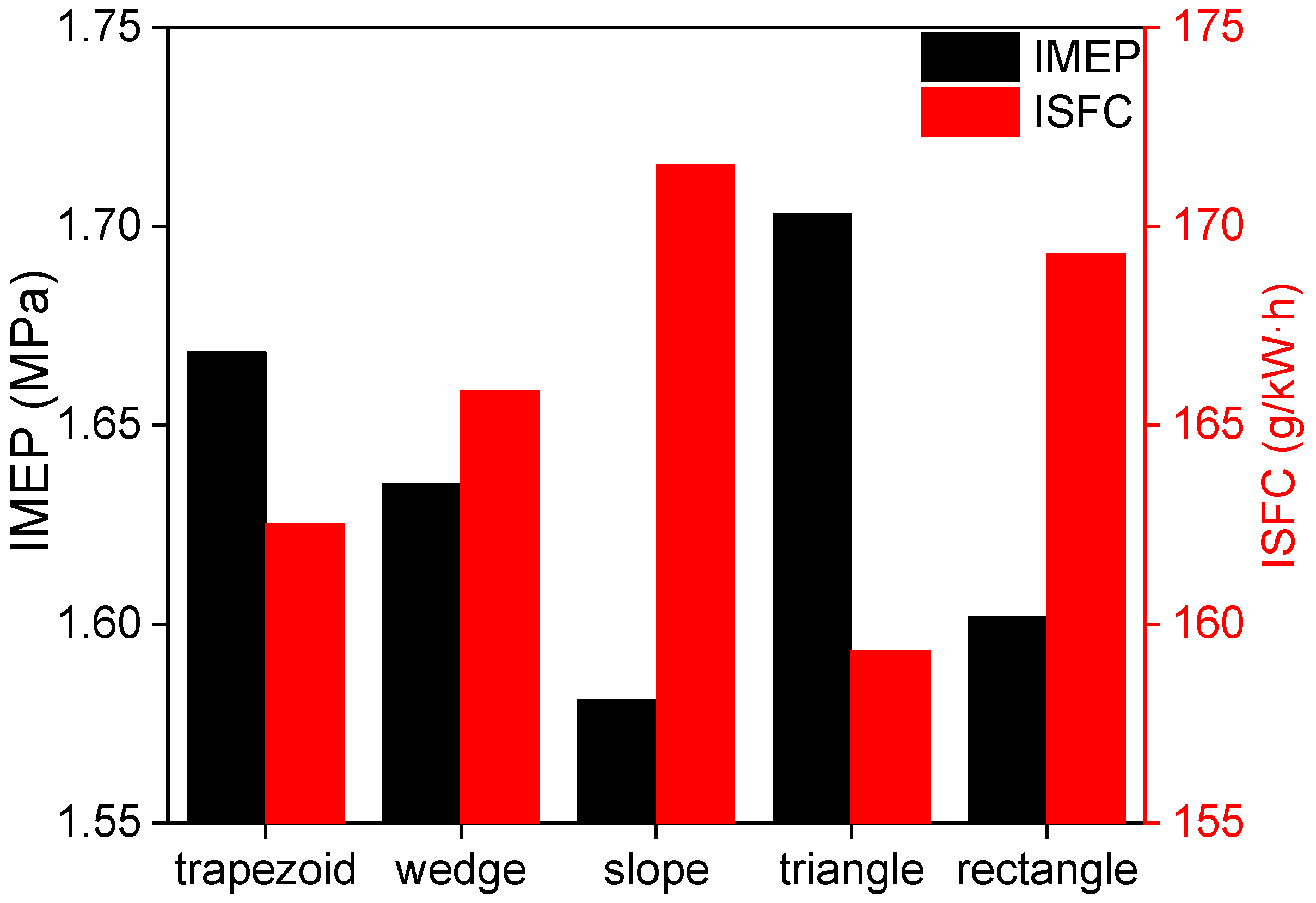
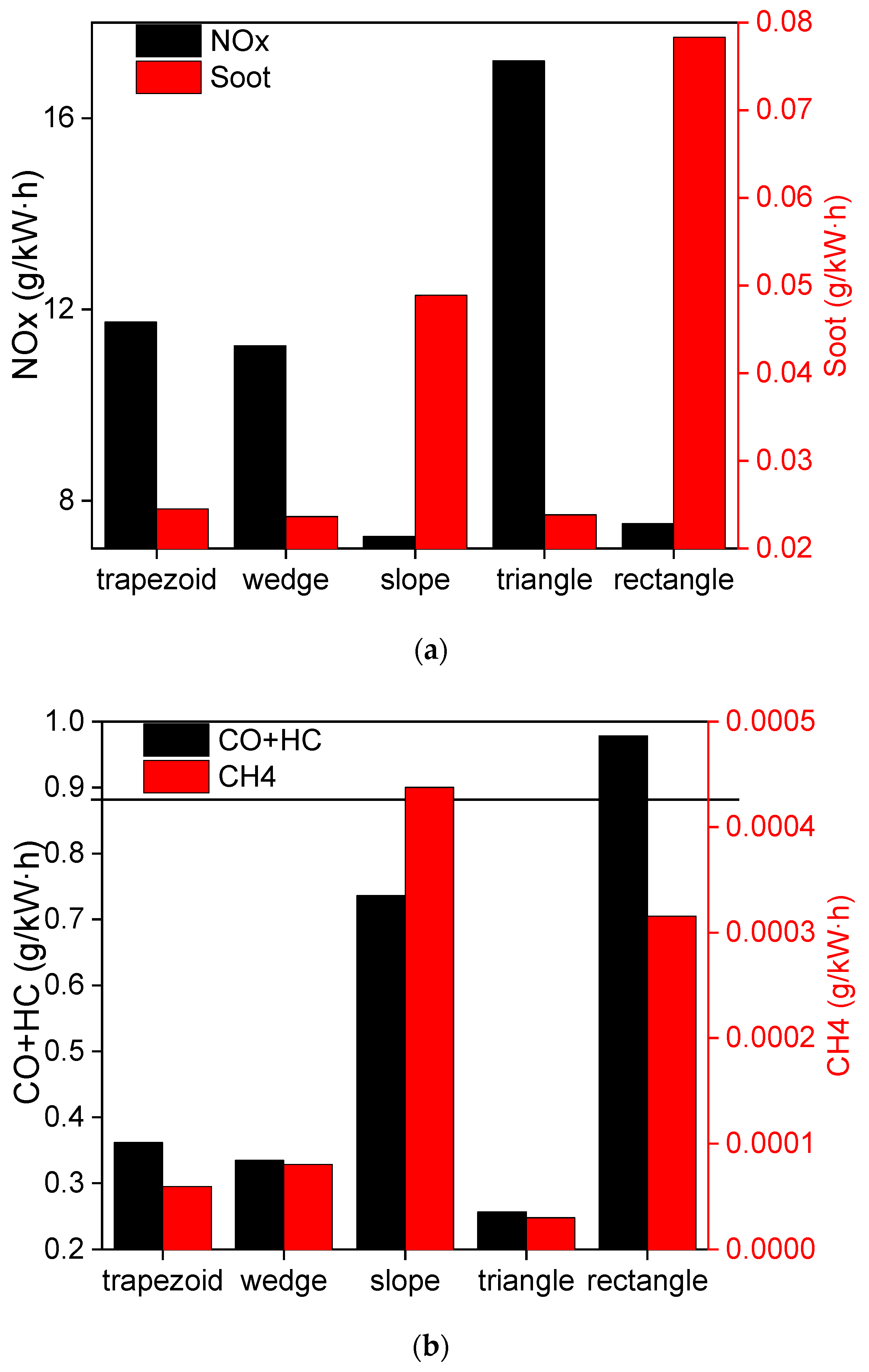

| Parameters | Value |
|---|---|
| Type | 4T50ME-GI |
| Number of cylinders | 4 |
| Bore/stroke | 500/2200 mm |
| Connecting rod | 2885 mm |
| Geometric compression ratio | 18.14 |
| Engine speed @ MCR | 123 rpm |
| Power @ MCR | 7050 kW |
| IMEP @ MCR | 20 bar |
| Turbocharger | MAN TCA55-VTA |
| Phenomenon | Model | Reference |
|---|---|---|
| Droplet collision | NTC collision method | [47] |
| Spray–wall interaction | O’Rourke model | [48] |
| Spray atomization and breakup | Hybrid KH-RT | [49] |
| Gas injection | Inflow boundary | [50] |
| Turbulence | RNG κ-ε model | [51] |
| Combustion | SAGE | [52] |
| NOx | Extended Zeldovich model | [53] |
| Soot | Hiroyasu soot model | [54] |
| Experiment | Simulation | Error | |
|---|---|---|---|
| Pmax (MPa) | 16.82 | 16.764 | 0.33% |
| Pmax phase (°CA ATDC) | 11.44 | 10.8 | 5.6% |
| CA50(°CA) | 11.5 | 11.2 | 2.6% |
| λ | 2.45 | 2.4 | 2% |
| ISFC(g/kWh) | 163.2 | 162.254 | 0.58% |
| Power output(kW) | 5331 | 5390.567 | 1% |
| NOx (g/kWh) | 11.9 | 11.621 | 2.3% |
| CO (g/kWh) | 0.19 | 0.192 | 1% |
| ATDC | Trapezoid | Wedge | Slope | Triangle | Rectangle |
|---|---|---|---|---|---|
| 0.5° CA |  | 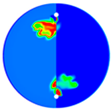 | 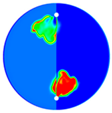 | 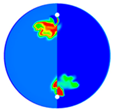 |  |
| 5.5° CA | 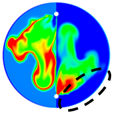 |  | 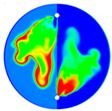 |  | 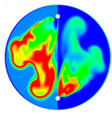 |
| 10.5° CA |  |  | 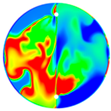 |  | 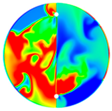 |
| 15.5° CA | 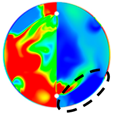 |  | 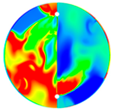 |  | 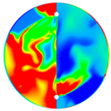 |
| 20.5° CA | 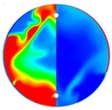 |  | 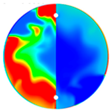 | 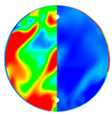 | 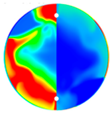 |
 | |||||
| ATDC | Trapezoid | Wedge | Slope | Triangle | Rectangle |
|---|---|---|---|---|---|
| 0.5 deg | 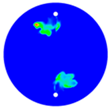 |  | 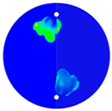 | 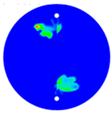 | 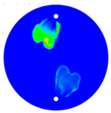 |
| 10.5 deg | 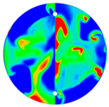 | 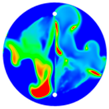 |  | 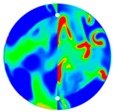 | 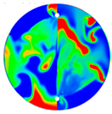 |
| 20.5 deg | 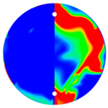 | 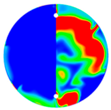 | 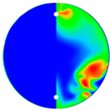 | 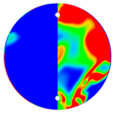 |  |
| 30.5 deg | 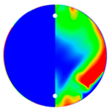 | 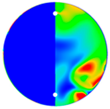 | 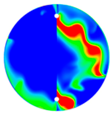 | 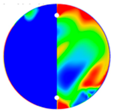 | 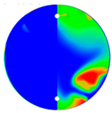 |
 | |||||
© 2019 by the authors. Licensee MDPI, Basel, Switzerland. This article is an open access article distributed under the terms and conditions of the Creative Commons Attribution (CC BY) license (http://creativecommons.org/licenses/by/4.0/).
Share and Cite
Li, J.; Wang, J.; Liu, T.; Dong, J.; Liu, B.; Wu, C.; Ye, Y.; Wang, H.; Liu, H. An Investigation of the Influence of Gas Injection Rate Shape on High-Pressure Direct-Injection Natural Gas Marine Engines. Energies 2019, 12, 2571. https://doi.org/10.3390/en12132571
Li J, Wang J, Liu T, Dong J, Liu B, Wu C, Ye Y, Wang H, Liu H. An Investigation of the Influence of Gas Injection Rate Shape on High-Pressure Direct-Injection Natural Gas Marine Engines. Energies. 2019; 12(13):2571. https://doi.org/10.3390/en12132571
Chicago/Turabian StyleLi, Jingrui, Jietuo Wang, Teng Liu, Jingjin Dong, Bo Liu, Chaohui Wu, Ying Ye, Hu Wang, and Haifeng Liu. 2019. "An Investigation of the Influence of Gas Injection Rate Shape on High-Pressure Direct-Injection Natural Gas Marine Engines" Energies 12, no. 13: 2571. https://doi.org/10.3390/en12132571
APA StyleLi, J., Wang, J., Liu, T., Dong, J., Liu, B., Wu, C., Ye, Y., Wang, H., & Liu, H. (2019). An Investigation of the Influence of Gas Injection Rate Shape on High-Pressure Direct-Injection Natural Gas Marine Engines. Energies, 12(13), 2571. https://doi.org/10.3390/en12132571






